|
MANASSAS National Battlefield Park |
 |
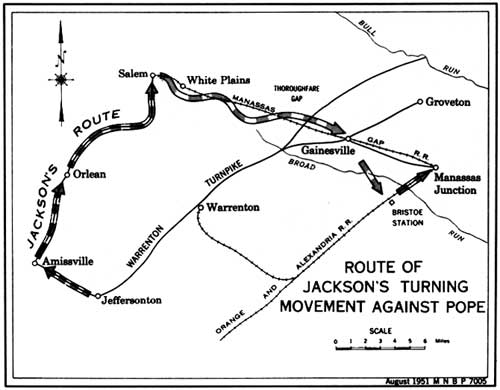
(click on map for larger image)
Lee's Operations Along the Rapidan and Rappahannock
Pope's center was now at Cedar Mountain, his right at Robertson's River, and his left near Raccoon Ford on the Rapidan. Thus stationed, his army was directly opposite Gordonsville where Jackson's force had recently arrived. On Clark's Mountain (a high hill opposite Pope's left) the Confederates had established a signal station. From here, stretching for miles, could be seen the white tents of the Federal encampment dotting the Culpeper tablelands. Spurs from Clark's Mountain paralleled the Rapidan to Somerville Ford, located about 2 miles from Raccoon Ford.
Lee was quick to appreciate the advantage this topography afforded him. Massing his troops behind Clark's Mountain he might move under its protecting screen, fall upon Pope's left at Somerville Ford, and cur off his retreat to Washington. The opportunity held bright possibilities of success, and August 18 was set as the date for the initiation of the movement. Unforeseen delays postponed the movement until the 20th. Worse still for the Confederates, Stuart's adjutant general was captured, bearing a copy of Lee's order.
Thus warned, Pope withdrew his army behind the Rappahannock. Lee followed closely on the 20th, crossing to the north side of the river. Pope took up an advantageous position where he stood fast during 5 days of feints and demonstrations as Lee sought eagerly for an opening on the right. In the meantime, Stuart had captured Pope's headquarters. Thus, Lee learned that 20,000 troops, composing the corps of Heintzelman and Porter and the division of Reynolds, were within 2 days' march of the front. Within 5 days other expected reinforcements would swell Pope's numbers to about 130,000 men.
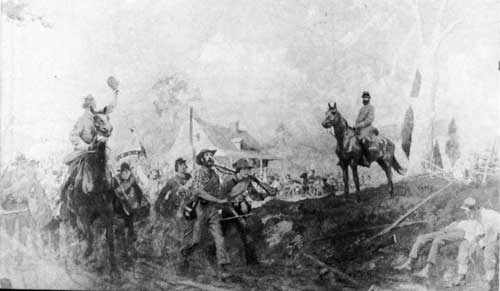
Jackson and his foot cavalry.
From the
painting by Hoffbauer in Battle Abbey, Richmond, Va. Courtesy Virginia Historical
Society.
The situation was so desperate as to demand a bold expedient. Quickly, Lee made his decision. Jackson, with Stuart's cavalry comprising about 24,000 men, was to be sent on a wide flanking movement of Pope's right for the purpose of destroying his communications with Washington. Commenting on this decision, Henderson, the English biographer of Jackson, says "we have record of few enterprises of greater daring."
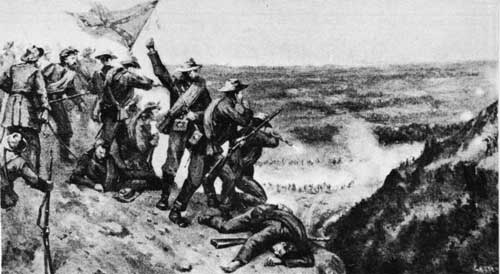
Longstreet's troops skirmishing at Thoroughfare
Gap.
From "Manassas to Appomattox."
With Lee and Longstreet covering the line of the Rappahannock, Jackson began his march from Jeffersonton on August 25. He moved through Amissville and Orlean to bivouac that night at Salem. The next day he pushed on past Thoroughfare Gap and Gainesville to Bristoe. Never did the "foot cavalry" better deserve its name for in 2 days it had covered approximately 51 miles. That night Jackson sent Stuart and two regiments to Manassas Junction to capture Pope's great base of supplies. The task was accomplished with little effort.
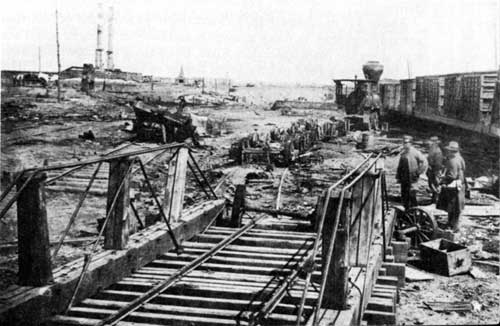
Manassas Junction, Va., as it looked after
Jackson's raid.
War time photograph. Courtesy National Archives.
The next day Jackson left Ewell to cover the rear at Bristoe and moved with the rest of his command to Manassas Junction. There then followed a scene of feasting and plunder the like of which has seldom been witnessed. Knapsacks, haversacks, and canteens were filled with articles of every description. Added to vast quantities of quartermaster and commissary supplies were innumerable luxuries from sutler stores, including expensive liquors and imported wines. An eyewitness writes, "To see a starving man eating lobster salad & drinking rhine wine, barefooted & in tatters was curious; the whole thing is indescribable." What could not be eaten or carried away was finally put to the torch. With the destruction of these supplies one of the chief objectives of the campaign had been accomplished.
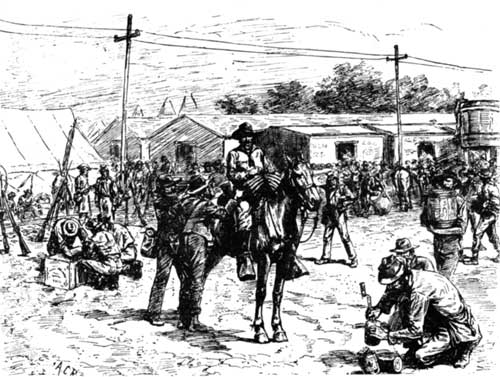
Jackson's troops pillaging Federal supplies at
Manassas Junction just prior to the Second Battle of Manassas.
From
"Battles and Leaders of the Civil War."

|

|
|
Last Modified: Sat, Apr 7 2001 10:00:00 am PDT |


